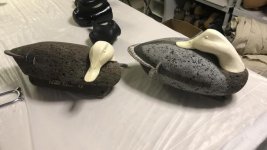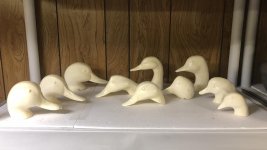I have been messing with this off and on for a few years now. Some work good, some not so good. Still learning how to orient and mold so that the casts come out clean, and don't leak!
As the materials are not cheap, I try to make sure I have enough staged to use the entire kit within a few days to a week.....
These are not all mine. Some are plugs carved by others, making molds for them. Some are for me to increase my library of heads to be cast..... my shop therapy, and side hustle that supports my decoy and boat addictions......

15 plugs are sanded, filled, and as good as can be (within reason). Multiple coats of lacquer are built up to get a "plastic" like finish. Just before the Rebound 25 silicone is applied, a release spray is applied.

At this point 4 or more layers have been built up. After the first 2 coats are applied straight, a thickener is added to the silicone so that it does not flow and builds up faster. Getting it applied on undercuts and vertical surfaces, without introducing air bubbles is a challenge.

After the silicone is cured, I wrap the molds in Saranwrap. Then the cardboard is set to support the first half of the mothermold. The saranwrap is a new step. I found that the epoxy would flow into creases and become shards that stab and puncture.

Here the 2 halves of the mothermold are curing.

Cardboard removed, molds trimmed while epoxy is still "green"

Plexiglass base plates are made in case foam will be cast. This contains the foam and makes a denser casting. A pour hole is drilled in the plexiglass and it is either clamped or bolted to the fiberglass mothermold.

These are some of the molds being filled. I used Feather Lite which is a 2 part filled resin that does not expand, so the fiberglass is only used to support the mold.

These are the "first" casts from each new mold. The 3 hooded merg heads where carved by Bob Romstadt. The left is a Herters goose, and the right is some magnum head a friend sent me.

In this picture more "firsts".... Herters 72 diver, puddler, a Super mag diver, in the middle are a couple mallard/black heads, then a Restle brant, and an odd brant in the backrow. The Lake Champlain Whistler and the Woodduck heads are carved by John Bourbon, and finally the Herters 63 coot.

I picked up 17 of these cork bodies in Bolivar, OH last year, there were only 4 heads. 3 sleepers and one drinker like on the left. I picked the best 2 and used them as the plugs for this mold. I cast all the heads in the new molds with Smooth-on Feather-Lite, which I have used for all the heads I have cast thus far. It is too expensive and heavy for the really big heads, but some of these were made for others with the understanding that I can make a mold for my use/reproduction. So I wanted a robust plug to keep in my library. Having used up all my material, I just found out that due to supply chain issues, Feather-Lite maybe in short supply. I have both 4lb and 8lb foam on hand, so I will learn the swish coating and foam process on the bigger molds.
I also have 5 or 6 body molds to make next, so plenty of shop time now that the season is done.
Yesterday, I brought in all the decoys, so the shelves are full again, and the bags are standing near the dehumidifier to dry before they get binned and stored until next Fall.
Something I was instructed to do was to grind up the scraps and old molds and use the grindings as filler in the 3rd or more coats, after the detail coats have set up, to extend the Rebound 25. So I will break out the sausage grinder and give it a go on the bodies as they have little detail anyway.

Last edited:
